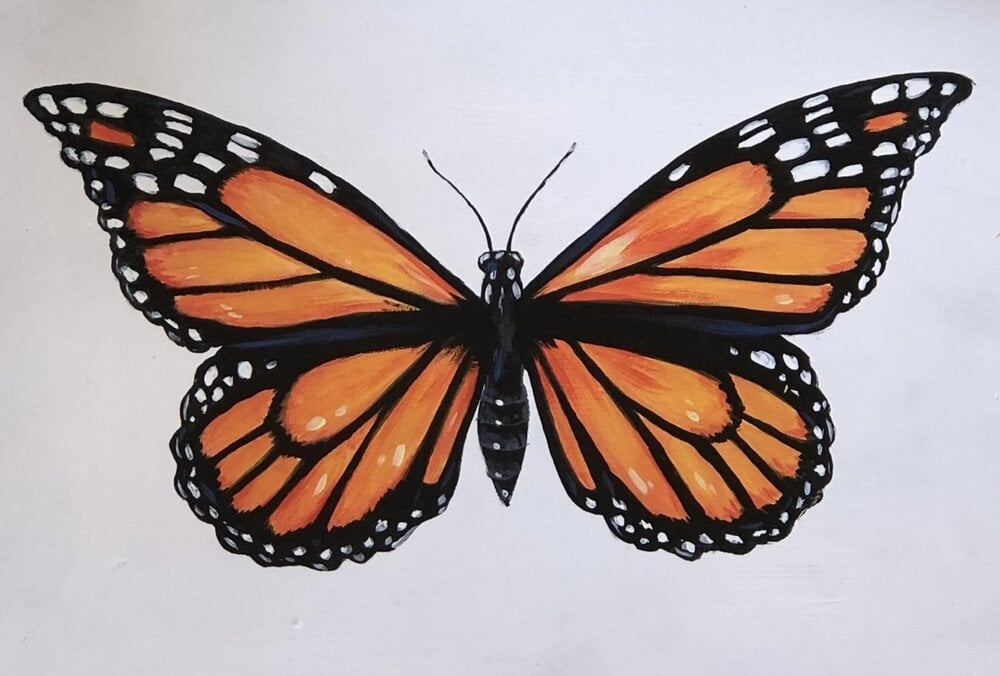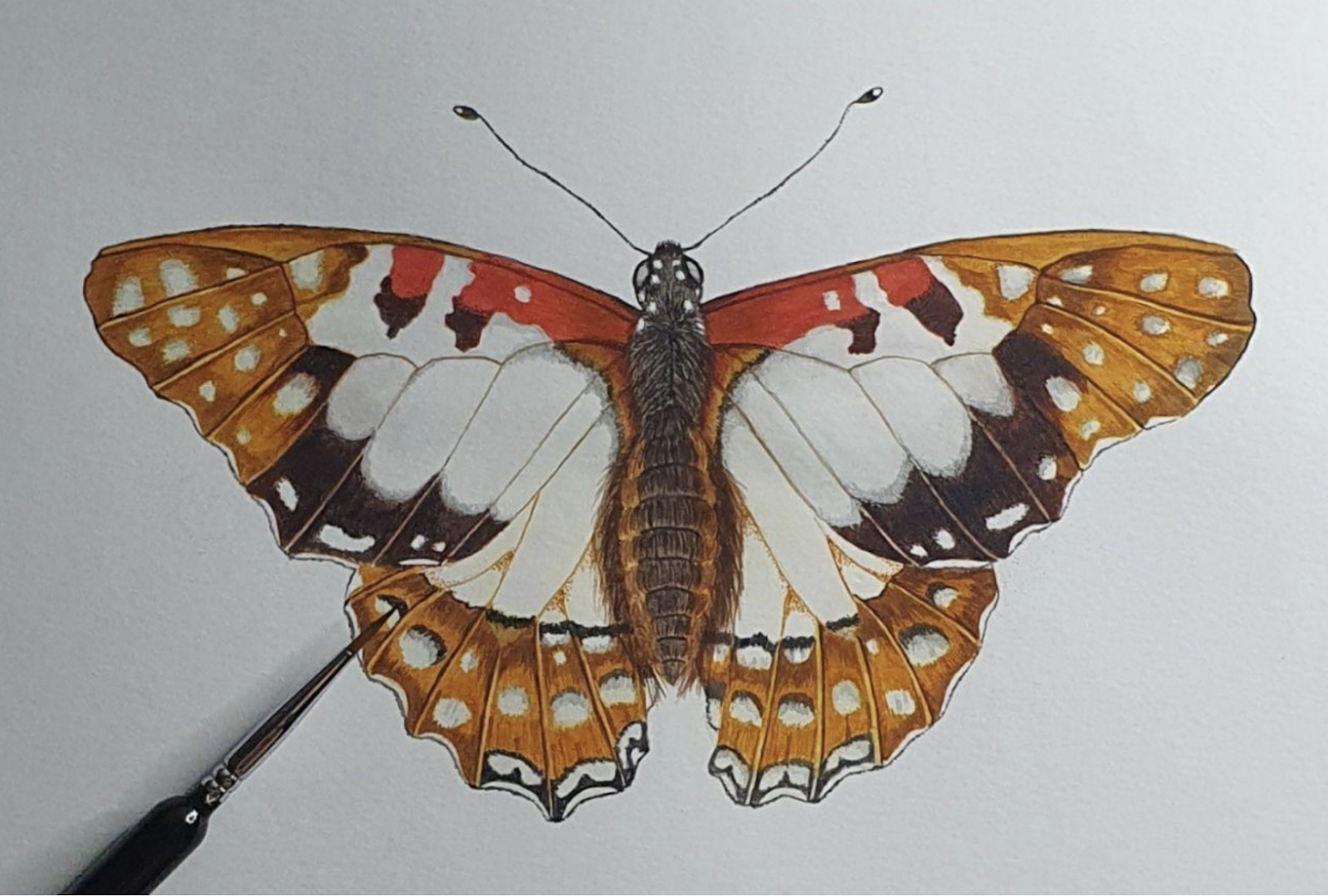Can a simple pencil and paper truly capture the ephemeral beauty of a butterfly? The answer is a resounding yes; a butterfly pencil drawing is a timeless pursuit, offering a unique blend of artistic challenge and serene satisfaction for artists of all levels. The delicate dance of light and shadow, the intricate patterns of the wings, and the graceful form of these creatures make them ideal subjects for artistic exploration.
Butterflies, with their kaleidoscope of colors and intricate wing designs, are a perennial favorite for artists. Whether a novice eager to grasp the fundamentals of line and shape or an accomplished artist seeking to master the nuances of detail, the butterfly offers a rich canvas for creative expression. It is a subject that invites both meticulous study and imaginative interpretation, making it a perfect project for anyone looking to hone their drawing skills.
The art of drawing a butterfly is more than just replicating an image; it's an exercise in observation, patience, and precision. Starting with the basics, like the head and body, one can gradually build up the complexity of the wings, antennae, and intricate patterns that make each butterfly unique. Tutorials often suggest beginning with simple shapes: a head, a body, and then the wings, mirroring each other for symmetry. The antennae, delicately curved and swirled at the ends, can be added next, giving the drawing a touch of life and movement. These initial steps lay the foundation for a successful butterfly drawing.
Drawing a butterfly can be broken down into simple, manageable steps. First, sketch the head and body, using gentle curves and ovals. Then, draw two curved lines extending from the top of the head for the antennae, with a swirl at each end. The wings are then sketched, remembering that they are often mirror images of each other. The outline serves as a guide, and the artist can then begin to fill in the details, such as the venation patterns and the unique patterns on the wings.
To truly capture the essence of a butterfly, the artist must study their subjects with a keen eye. Paying attention to the subtle detailsthe texture of the wings, the way light plays on their surfaces, the unique patterns that identify each speciesis crucial. Reference images, whether photographs or illustrations, are invaluable resources for understanding these complexities. These images provide the basis for recreating the patterns, colors, and textures that define these delicate creatures.
The world of butterfly drawing is vast, encompassing various styles, from realistic to stylized. Some artists might prefer to replicate the precise details of a monarch butterfly, with its striking orange and black patterns, while others might opt for a more whimsical approach, inventing their own imaginative designs. Regardless of the style, the fundamental principles remain the same: start with the basics, pay attention to detail, and let your creativity flow.
- Matteo Berrettini Net Worth The Financial Success Of A Tennis Star
- Michael Wright Net Worth A Comprehensive Look At His Wealth And Career
Learning to draw a butterfly is a journey of discovery, not just of artistic technique but also of the natural world. It encourages a deeper appreciation for the beauty and intricacies of nature. Moreover, its a skill that can be readily applied to other subjects, improving overall artistic abilities. The simple act of drawing a butterfly can be a meditative practice, a way to escape the pressures of daily life and immerse oneself in the beauty of art and nature.
The allure of drawing a butterfly lies not only in its aesthetic appeal but also in its accessibility. Unlike more complex subjects, butterflies are relatively straightforward to draw, making them an excellent starting point for beginners. Even without a tutorial, a simple butterfly can be drawn with basic shapes and lines. However, as skills develop, one can add detail to create a more realistic and impressive artwork.
A simple butterfly drawing tutorial might involve a basic outline of the body and wings. More complex tutorials might guide the artist in creating a realistic butterfly drawing, capturing its delicate wings, intricate patterns, and realistic body, incorporating various tools such as colored pencils, graphite, or even digital brushes. They often incorporate step-by-step instructions, often with visual aids, and a focus on accuracy and detail. These tutorials break down the process into manageable steps, from outlining the body and wings to adding patterns and shading.
The use of templates, guides, patterns, and shading techniques can transform a simple line into a stunning butterfly. The process of drawing allows for the exploration of a wide range of styles and effects, encouraging the artist to experiment with different shapes, sizes, and techniques. Some tutorials focus on drawing cute and colorful butterflies, while others focus on more realistic depictions, such as the Monarch butterfly.
Butterflies are often associated with joy, beauty, and transformation. The act of drawing one is an exercise in mindfulness, where the artist focuses on the present moment and the delicate details before them. Creating a butterfly from scratch can offer feelings of accomplishment and pride.
In drawing, symmetry is critical, particularly when depicting butterflies. The wings usually have a nearly perfect mirror image of each other. The body is typically a simple shape, and the antennae and other features are carefully positioned for balance. The techniques for creating symmetry involve using a centerline to divide the paper and then drawing one half of the butterfly before replicating it on the other side.
The process of drawing a butterfly offers numerous benefits, extending beyond artistic skill development. It enhances observation skills, improves hand-eye coordination, and promotes creativity. Breaking down the complex form of a butterfly into simple steps allows for a clear understanding of its structure, thus improving the artist's ability to see and replicate the subject accurately. This process helps the artist not only to draw well but also to express creativity effectively.
Drawing a butterfly is an engaging and rewarding experience, no matter the artist's experience level. It starts with fundamental shapes and lines, gradually building detail and complexity. This process can begin with the basics, like the head and body, and then move to the wings and intricate patterns, using clear instructions and detailed explanations.
Different butterfly species also require different approaches. For a monarch butterfly, a step-by-step tutorial would guide the artist in creating the body, wings, cells, and the unique patterns of this species, emphasizing the use of colored pencils and graphite for shading techniques. The approach to drawing a butterfly will be guided by the specific features of each species, making the learning process comprehensive.
Drawing a butterfly allows for an exploration of many styles, from realistic to stylized. Some artists might choose to replicate the specific details of a Monarch butterfly, with its vivid orange and black patterns. Others could prefer a more whimsical method, inventing their patterns. Whether realistic or stylized, the essential concepts remain the same: to start from the basics, pay attention to detail, and allow your creativity to soar.
The internet is filled with tutorials, from basic sketches to detailed illustrations. Many tutorials include video guides and instructions to aid in the drawing process, which provides easy steps for a beginner to draw a butterfly. These tutorials also provide resources, such as free graphic resources, vectors, stock photos, and PSD files.
The first time you attempt to draw a butterfly, it might not perfectly resemble the colorful, delicate creature you have in mind. It might seem more like an unusual paper plane. This is perfectly normal. The key is to stay curious. Study the shape of butterflies, their patterns, and the delicate nature of their wings.
To create a butterfly, start with the outline of its body and then complete it with oval shapes. Place the first oval above the middle point of the centerline, defining the thorax or breast area. Then, add the wings, remembering that the wings are a mirror image. Fill in the wings with patterns.
Many tutorials online range from overly simplistic to overly complex. A simpler approach focuses on drawing the wings with a few circles. More complex tutorials may involve creating Monarchs with dozens of shapes. No matter the method, drawing a butterfly should be enjoyable.
The butterfly, often depicted with fluttering wings, evokes feelings of joy and excitement. Drawing a butterfly is a way to translate that joy onto paper, expressing the beauty and wonder of the insect world. It helps the artist to focus on the present and the delicate details.


Detail Author:
- Name : Marco Zulauf V
- Username : erwin02
- Email : legros.lisette@yahoo.com
- Birthdate : 1985-08-11
- Address : 94356 Jarrett Squares Port Spencerton, WY 61469-8057
- Phone : +1-925-576-0854
- Company : Renner, Ortiz and Schmitt
- Job : Agricultural Equipment Operator
- Bio : Consequatur voluptates ut et ut et quia. Distinctio et at dolore molestias. Eos voluptas ut dolores nemo. Qui pariatur illo et maxime at.
Socials
linkedin:
- url : https://linkedin.com/in/shayne_real
- username : shayne_real
- bio : Eum occaecati fuga autem quam dolore.
- followers : 753
- following : 1013
twitter:
- url : https://twitter.com/shaynegoldner
- username : shaynegoldner
- bio : Ab laudantium enim non qui tenetur ipsam. Quia aut maiores placeat. Quo ab et ullam est eum.
- followers : 4651
- following : 2751
instagram:
- url : https://instagram.com/goldner1995
- username : goldner1995
- bio : Et ea porro non nobis. Sunt quam itaque ut. Et nam suscipit quidem.
- followers : 139
- following : 165
tiktok:
- url : https://tiktok.com/@shayne5967
- username : shayne5967
- bio : Sed est nobis error optio est aut impedit eos.
- followers : 742
- following : 1527